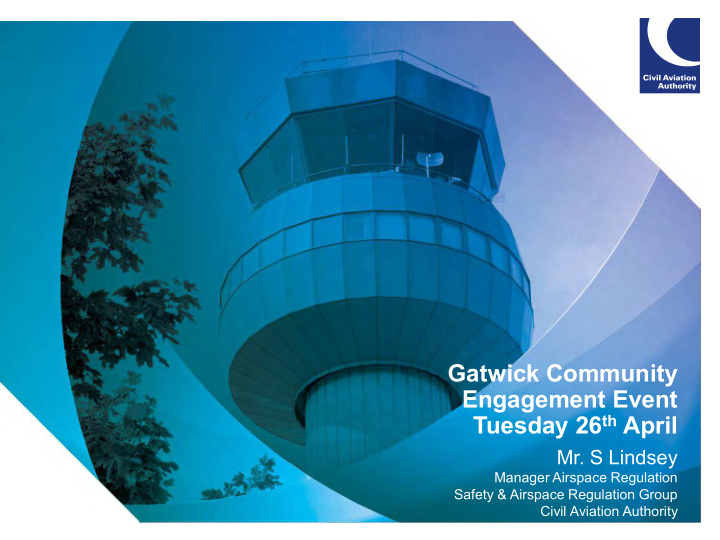



Gatwick Community Engagement Event Tuesday 26 th April Mr. S Lindsey Manager Airspace Regulation Safety & Airspace Regulation Group Civil Aviation Authority 1
The Civil Aviation Authority – Our Role The CAA is the UK's specialist, independent aviation regulator. Its regulatory activities range from making sure that the aviation industry meets the highest safety, operational and technical standards, to preventing holidaymakers from being stranded abroad or losing money because of tour operator insolvency. Airspace is one of the key roles of the CAA. As such we own the Airspace Change Process under which proposals for change are submitted to us for approval. Operate under the auspices of the Transport Act 2000, Directions from Government (signed by both the Secretary of State for Transport and the Secretary of State for Defence) and within Environmental Guidance issued by the DfT (last amended in February 2014). Airspace Change Process and the Guidance for it set out in Civil Aviation Publications 724 and 725 ( currently consulting upon changes ). 2
How airspace works 3
Airspace Designed For A Different Era Yesterday Today 4
5
All Flights below FL195 – 1 day Luton Stansted Dutch airspace London Heathrow City British Belgian airspace airspace Gatwick French airspace Slide 6 6 NATS PRIVATE
Modernising Uk’s Airspace – The Need for Change Airspace arrangements 40 years old – tweaked over the years Global navigation performance standard is Performance Based Navigation – what the International Civil Aviation Organisation (ICAO) and European Aviation Safety Agency (EASA) expects. Aircraft come equipped to this standard off the production line. Old ground based infrastructure no longer being replaced ‘as is’. Provides opportunities for doing things differently CAA’s Future Airspace Strategy –safety, capacity, environment and efficiency at its heart. It is not a blueprint of an airspace design; more a shopping list of technologies and methods to be deployed. For ‘Industry’ to design and implement. 7
Considerations & Challenges Fully recognising the strength of public feeling – Gatwick PIR first time CAA have had this level of public engagement Balancing the requirements of the airport with the requirements of local communities is a challenge Working to make the language clear and comprehensible Limitations and complexities of UK airspace – not just Gatwick Move away from ground based navigation to satellite systems; limitations of Performance Based Navigation in all weather conditions. Confusing backdrop: Concurrent changes/trials at other airports, discussions on 2nd runway, ADNID trial, other airspace change consultations or arrivals vectoring. 8
Airspace Change Process • Airspace Charter (CAP 724) provides a high- level description of CAA’s responsibilities and principles to conduct the planning of airspace in the UK • CAA Guidance on the Application of the Airspace Change Process (CAP 725) provides guidance on the process for changes to UK airspace 9
Airspace Change Process • Purpose of the Airspace Change Process Stage 1 Framework Briefing • Method used to satisfy CAA’s Statutory Duties: • Maintain a high standard of safety in the provision of Stage 2 Proposal Development Air Traffic Services Preparing for Stage 3 • Secure the most efficient use of airspace Consultation • Take account of guidance on environmental Consultation and objectives Stage 4 Formal Proposal Submission • Provides a framework for Change Sponsors to develop and submit an airspace change proposal to Airspace Stage 5 Regulatory Approval Regulation (AR) for regulatory approval. Stage 6 Implementation • Defines the Roles and Responsibilities of those involved. • Provides specific guidance for consultation and Stage 7 Operational Review conducting environmental assessments. • Conduit for promulgation of permanent changes to the [established] notified airspace structure in the UK Aeronautical Information Publication 10
Temporary changes to notified structure and Airspace Trials DfT’s Air Navigation Guidance (2014) – Paragraph 9.10 • Due to the short term nature of temporary airspace changes and airspace trials, it will usually not be necessary or appropriate for the airspace change sponsor to consult on their proposals or to undertake the airspace change approval process. However, the likely impact of the proposed change on the environment should be considered by the sponsor prior to implementation and this information used to help the CAA to determine whether a proportionate consultation is required. 11
Airspace Change Process Helios Independent Review Initiated in Jul 15 as an independent review of the Airspace Change Process Interviews & workshops involved a wide range of aviation & non-aviation stakeholders Report received by CAA in Nov 15, and published in Dec 15 Key recommendations: Improving transparency of the Process Improving clarity Improving information sharing on individual proposal & regulator actions Next Steps: CAA consult publicly on the Helios concepts – launched last month Feedback to be used in developing a revised Airspace Change Process CAP 725 administrative update: To coincide with the CAA consultation on the Helios recommendations Limited to the update of legislative and organisational changes 12
The proposed new process 13
Review Timeline 14
Thank you 15
Recommend
More recommend